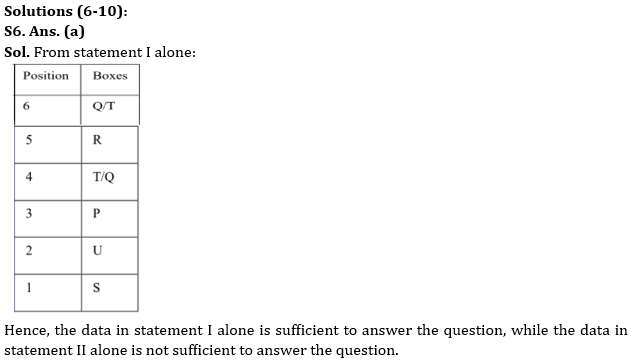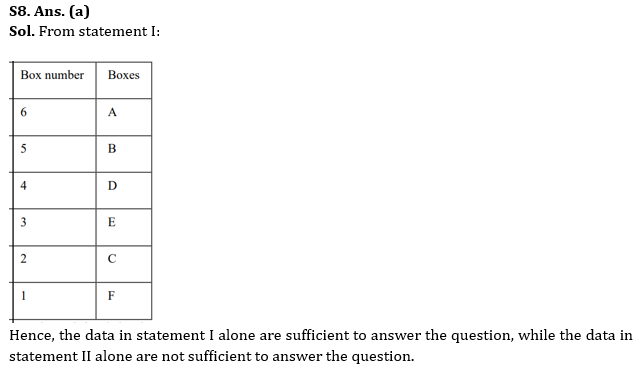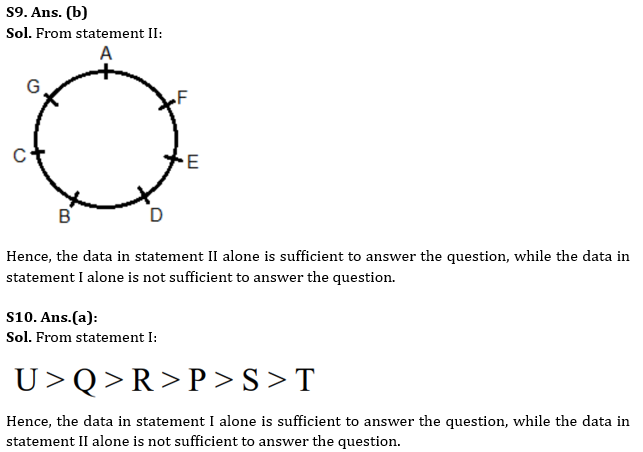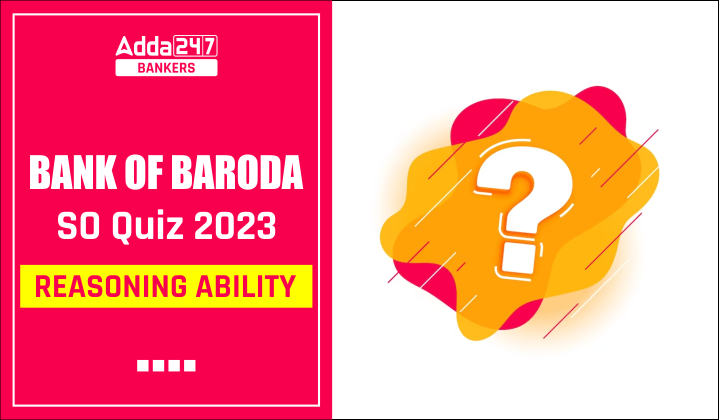Directions (1-5): Study the following series carefully and answer the questions given below:
4 2 3 5 1 4 9 4 1 5 2 8 3 9 1 4 1 2 5 7 3 5 9 6 4 2 5 1 8 5 2 3 4
Q1. How many 3s are in the given series, each of which is immediately preceded by a digit which has a numerical value of more than five?
(a) None
(b) One
(c) Two
(d) Three
(e) More than three
Q2. How many such 1s are in the given series, each of which is immediately preceded by an odd digit and immediately followed by an even digit?
(a) None
(b) One
(c) Two
(d) Three
(e) More than three
Q3. What is the sum of the digit which is 12th from the left end and 16th from the right end?
(a) 10
(b) 15
(c) 7
(d) 6
(e) 5
Q4. Which of the following is 7th to the right of 20th from the left end in the given series?
(a) 8
(b) 5
(c) 2
(d) 4
(e) 1
Q5. If all the odd digits are deleted (dropped) from the given series, then which of the following will be ninth from the right end of the arrangement?
(a) None
(b) 8
(c) 6
(d) 4
(e) 2
Directions (6-10): Each of the questions below consists of a question and two statements numbered I and II given below it. You have to decide whether the data provided in the statements are sufficient to answer the question. Read all the statements and answer the following questions.
Q6. Six boxes, P, Q, R, S, T and U are placed one above another (but not necessarily in the same order) where the bottommost position is 1 and the position just above it is 2 and so on. Which box is placed at the bottommost position?
I. R is placed 2nd to the above of P which is placed just above of U. One box is placed between Q and T. S is placed below T.
II. Two boxes are placed between Q and P. One box is placed between R and P.
(a) The data in statement I alone is sufficient to answer the question while the data in statement II alone is not sufficient to answer the question.
(b) The data in statement II alone is sufficient to answer the question while the data in statement I alone is not sufficient to answer the question.
(c) The data either in statement I alone or in statement II alone is sufficient to answer the question.
(d) The data given in both statements I and II together are not sufficient to answer the question.
(e) The data in both statements I and II together are necessary to answer the question.
Q7. Six persons, A, B, C, D, E and F are of different heights. Who is the 3rd shortest person?
I. A and C are shorter than D. F is not taller than E. B is taller than E but not the tallest.
II. B is taller than A and is the 2nd tallest person. F is shorter than D. C is not the tallest person. E is shorter than A and C. E is not the shortest.
(a) The data in statement I alone are sufficient to answer the question while the data in statement II alone are not sufficient to answer the question.
(b) The data in statement II alone are sufficient to answer the question while the data in statement I alone are not sufficient to answer the question.
(c) The data either in statement I alone or in statement II alone are sufficient to answer the question.
(d) The data given in both statements I and II together are not sufficient to answer the question.
(e) The data in both statements I and II together are necessary to answer the question.
Q8. Six boxes A, B, C, D, E and F are kept one above one another (but not necessarily in the same order) such that bottommost box is numbered as 1 while the topmost box is numbered as 6. Which box is kept just below box C?
I. Box A is placed just above box B which is an odd number box. Box D is placed three boxes above box F but not the topmost box. Box E is placed just above box C.
II. Box A is placed three boxes above box E. Box B is placed above box E. Box F is placed below box E.
(a) The data in statement I alone is sufficient to answer the question while the data in statement II alone is not sufficient to answer the question.
(b) The data in statement II alone is sufficient to answer the question while the data in statement I alone is not sufficient to answer the question.
(c) The data either in statement I alone or in statement II alone is sufficient to answer the question.
(d) The data given in both statements I and II together are not sufficient to answer the question.
(e) The data in both statements I and II together are necessary to answer the question.
Q9. Seven persons A, B, C, D, E, F and G sit around a circular table facing towards the center but not necessarily in the same order. Who sits immediate right of F?
I. G sits 2nd to the right of F. Two persons sit between C and E. D sits adjacent to E and to the immediate right of B.
II. B sits 4th to the right of F. G sits 2nd to the left of B. D sits to the immediate left of E. C doesn’t sit next to F.
(a) The data in statement I alone is sufficient to answer the question while the data in statement II alone is not sufficient to answer the question.
(b) The data in statement II alone is sufficient to answer the question while the data in statement I alone is not sufficient to answer the question.
(c) The data either in statement I alone or in statement II alone is sufficient to answer the question.
(d) The data given in both statements I and II together are not sufficient to answer the question.
(e) The data in both statements I and II together are necessary to answer the question.
Q10. Six persons P, Q, R, S, T and U have different marks in a class test. Who has 2nd highest marks?
I. R has more marks than S and T. At least two persons have more marks than R. P has 3rd lowest marks. Q doesn’t have the highest marks. S doesn’t have the lowest marks.
II. Three persons have lesser marks than R. Neither Q nor U has fewer marks than R. P has more marks than S and T.
(a) The data in statement I alone are sufficient to answer the question while the data in statement II alone are not sufficient to answer the question.
(b) The data in statement II alone are sufficient to answer the question while the data in statement I alone are not sufficient to answer the question.
(c) The data either in statement I alone or in statement II alone are sufficient to answer the question.
(d) The data given in both statements I and II together are not sufficient to answer the question.
(e) The data in both statements I and II together are necessary to answer the question.
Solutions

S3. Ans. (a)
Sol. 12th from the left end= 8, 16th from the right end= 2
Required Sum= 10
S4. Ans. (b)
Sol. 7th to the right of 20th from the left end = 27th from the left end= 5
S5. Ans. (b)
Sol. New series = 4 2 4 4 2 8 4 2 6 4 2 8 2 4

S7. Ans. (d)
Sol. D > B > A/C > C/A > E > F
Clearly, data given in both statements I and II even together are not sufficient to answer the question.







 50+ Data Sufficiency Questions For Bank ...
50+ Data Sufficiency Questions For Bank ...
 Quantitative Aptitude Quiz For Bank Main...
Quantitative Aptitude Quiz For Bank Main...







